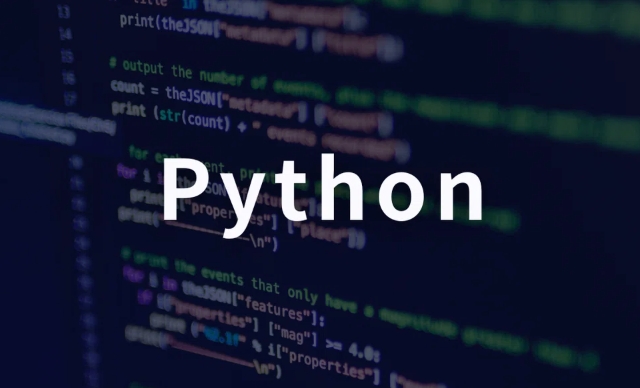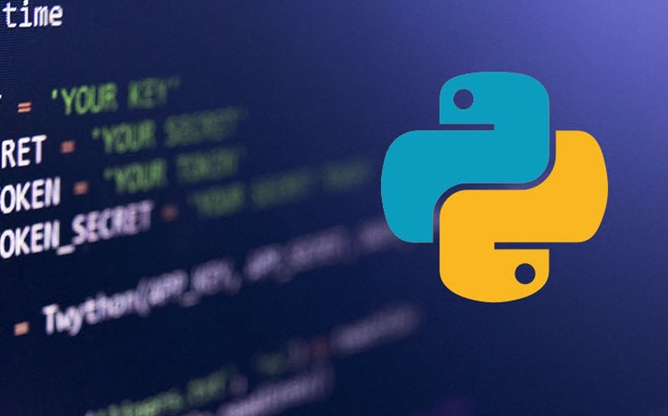Use the uuid module to obtain the MAC address of the first network card of the machine across the platform, without the need for a third-party library, and convert it to a standard format through uuid.getnode(); 2. Use subprocess to call system commands such as ipconfig or ifconfig, and combine it with regular extraction of all network card MAC addresses, which is suitable for scenarios where multiple network card information needs to be obtained; 3. Use the third-party library getmac, and call get_mac_address() after installation to obtain the MAC, which supports query by interface or IP, but requires additional dependencies; in summary, if no external library is needed, the uuid method is recommended. If you need to flexibly obtain multi-network card information, you can use the subprocess solution, which allows you to allow the most convenient way to install dependencies. Choose the appropriate method according to actual needs.

Obtaining MAC addresses can be implemented in Python in many ways. The following describes several common and practical methods that are suitable for Windows, Linux, and macOS systems.

1. Use uuid module (recommended, cross-platform)
This is the easiest and most general method, using the uuid module in the Python standard library to obtain the MAC address of the native machine.
import uuid
def get_mac_address():
mac = uuid.getnode()
# Convert integers to standard MAC address format (such as aa:bb:cc:dd:ee:ff)
mac_hex = ':'.join(['{:02x}'.format((mac >> (i * 8)) & 0xff) for i in range(5, -1, -1)])
return mac_hex
print("MAC Address:", get_mac_address()) ?Pros : No third-party library is required, compatible with all platforms.
??Note : The returned MAC of the first network card of the machine, which may not be an active network card, but it is valid in most cases.

2. Use subprocess to call system commands (more flexible)
Call the corresponding commands according to different operating systems (such as ipconfig /all in Windows, ifconfig or ip in Linux/macOS).
import subprocess
import re
import platform
def get_mac_address_by_cmd():
os_type = platform.system()
if os_type == "Windows":
cmd = "ipconfig /all"
elif os_type == "Linux":
cmd = "ifconfig"
elif os_type == "Darwin": # macOS
cmd = "ifconfig"
else:
return "Unsupported OS"
try:
output = subprocess.check_output(cmd, shell=True).decode()
# Find regular expressions for MAC addresses (common formats: xx:xx:xx:xx:xx:xx:xx:xx or xx-xx-xx-xx-xx-xx-xx-xx-xx-xx-xx-xx-xx-xx-xx-xx-xx-xx-xx-xx-xx-xx-xx)
mac_addresses = re.findall(r'([0-9a-fA-F]{2}[:-]){5}([0-9a-fA-F]{2})', output)
# Deduplicate and format unique_macs = list(set(re.findall(r'([0-9a-fA-F]{2}[:-]){5}([0-9a-fA-F]{2})', output)))
return [match[0][:-1] for match in unique_macs] # Extract the complete MAC
except Exception as e:
return f"Error: {e}"
print("MAC Addresses found:", get_mac_address_by_cmd()) ? Advantages : You can obtain the MAC address of multiple network cards.
??Note : Regular matching needs to be fine-tuned according to the system output format; ifconfig output formats for macOS and Linux are slightly different.

3. Use the third-party library getmac (simple but requires installation)
If you don't mind using third-party libraries, getmac is a convenient option.
Install:
pip install getmac
Example of usage:
from getmac import get_mac_address
# Get the local MAC
mac = get_mac_address()
print("MAC Address:", mac)
# You can also get the MAC for the specified IP or interface
# mac = get_mac_address(ip="192.168.1.1")
# mac = get_mac_address(interface="eth0") ? Advantages : The API is simple and supports multiple query methods.
?Disadvantages : Additional installation dependencies are required, and are not suitable for pure standard library environments.
Summary: Select a suggestion
- If you want to not rely on external libraries , using
uuid.getnode()is the easiest. - If you want to obtain the real active network card MAC or multiple network card information, use
subprocess 系統(tǒng)命令. - If the project allows the installation of packages, the
getmaclibrary is more intuitive and flexible.
Basically, just choose one of these commonly used methods according to your usage scenario.
The above is the detailed content of python get mac address example. For more information, please follow other related articles on the PHP Chinese website!

Hot AI Tools

Undress AI Tool
Undress images for free

Undresser.AI Undress
AI-powered app for creating realistic nude photos

AI Clothes Remover
Online AI tool for removing clothes from photos.

Clothoff.io
AI clothes remover

Video Face Swap
Swap faces in any video effortlessly with our completely free AI face swap tool!

Hot Article

Hot Tools

Notepad++7.3.1
Easy-to-use and free code editor

SublimeText3 Chinese version
Chinese version, very easy to use

Zend Studio 13.0.1
Powerful PHP integrated development environment

Dreamweaver CS6
Visual web development tools

SublimeText3 Mac version
God-level code editing software (SublimeText3)

Hot Topics
 VSCode settings.json location
Aug 01, 2025 am 06:12 AM
VSCode settings.json location
Aug 01, 2025 am 06:12 AM
The settings.json file is located in the user-level or workspace-level path and is used to customize VSCode settings. 1. User-level path: Windows is C:\Users\\AppData\Roaming\Code\User\settings.json, macOS is /Users//Library/ApplicationSupport/Code/User/settings.json, Linux is /home//.config/Code/User/settings.json; 2. Workspace-level path: .vscode/settings in the project root directory
 How to handle transactions in Java with JDBC?
Aug 02, 2025 pm 12:29 PM
How to handle transactions in Java with JDBC?
Aug 02, 2025 pm 12:29 PM
To correctly handle JDBC transactions, you must first turn off the automatic commit mode, then perform multiple operations, and finally commit or rollback according to the results; 1. Call conn.setAutoCommit(false) to start the transaction; 2. Execute multiple SQL operations, such as INSERT and UPDATE; 3. Call conn.commit() if all operations are successful, and call conn.rollback() if an exception occurs to ensure data consistency; at the same time, try-with-resources should be used to manage resources, properly handle exceptions and close connections to avoid connection leakage; in addition, it is recommended to use connection pools and set save points to achieve partial rollback, and keep transactions as short as possible to improve performance.
 python itertools combinations example
Jul 31, 2025 am 09:53 AM
python itertools combinations example
Jul 31, 2025 am 09:53 AM
itertools.combinations is used to generate all non-repetitive combinations (order irrelevant) that selects a specified number of elements from the iterable object. Its usage includes: 1. Select 2 element combinations from the list, such as ('A','B'), ('A','C'), etc., to avoid repeated order; 2. Take 3 character combinations of strings, such as "abc" and "abd", which are suitable for subsequence generation; 3. Find the combinations where the sum of two numbers is equal to the target value, such as 1 5=6, simplify the double loop logic; the difference between combinations and arrangement lies in whether the order is important, combinations regard AB and BA as the same, while permutations are regarded as different;
 Mastering Dependency Injection in Java with Spring and Guice
Aug 01, 2025 am 05:53 AM
Mastering Dependency Injection in Java with Spring and Guice
Aug 01, 2025 am 05:53 AM
DependencyInjection(DI)isadesignpatternwhereobjectsreceivedependenciesexternally,promotingloosecouplingandeasiertestingthroughconstructor,setter,orfieldinjection.2.SpringFrameworkusesannotationslike@Component,@Service,and@AutowiredwithJava-basedconfi
 python pytest fixture example
Jul 31, 2025 am 09:35 AM
python pytest fixture example
Jul 31, 2025 am 09:35 AM
fixture is a function used to provide preset environment or data for tests. 1. Use the @pytest.fixture decorator to define fixture; 2. Inject fixture in parameter form in the test function; 3. Execute setup before yield, and then teardown; 4. Control scope through scope parameters, such as function, module, etc.; 5. Place the shared fixture in conftest.py to achieve cross-file sharing, thereby improving the maintainability and reusability of tests.
 Python for Data Engineering ETL
Aug 02, 2025 am 08:48 AM
Python for Data Engineering ETL
Aug 02, 2025 am 08:48 AM
Python is an efficient tool to implement ETL processes. 1. Data extraction: Data can be extracted from databases, APIs, files and other sources through pandas, sqlalchemy, requests and other libraries; 2. Data conversion: Use pandas for cleaning, type conversion, association, aggregation and other operations to ensure data quality and optimize performance; 3. Data loading: Use pandas' to_sql method or cloud platform SDK to write data to the target system, pay attention to writing methods and batch processing; 4. Tool recommendations: Airflow, Dagster, Prefect are used for process scheduling and management, combining log alarms and virtual environments to improve stability and maintainability.
 Understanding the Java Virtual Machine (JVM) Internals
Aug 01, 2025 am 06:31 AM
Understanding the Java Virtual Machine (JVM) Internals
Aug 01, 2025 am 06:31 AM
TheJVMenablesJava’s"writeonce,runanywhere"capabilitybyexecutingbytecodethroughfourmaincomponents:1.TheClassLoaderSubsystemloads,links,andinitializes.classfilesusingbootstrap,extension,andapplicationclassloaders,ensuringsecureandlazyclassloa
 How to work with Calendar in Java?
Aug 02, 2025 am 02:38 AM
How to work with Calendar in Java?
Aug 02, 2025 am 02:38 AM
Use classes in the java.time package to replace the old Date and Calendar classes; 2. Get the current date and time through LocalDate, LocalDateTime and LocalTime; 3. Create a specific date and time using the of() method; 4. Use the plus/minus method to immutably increase and decrease the time; 5. Use ZonedDateTime and ZoneId to process the time zone; 6. Format and parse date strings through DateTimeFormatter; 7. Use Instant to be compatible with the old date types when necessary; date processing in modern Java should give priority to using java.timeAPI, which provides clear, immutable and linear






